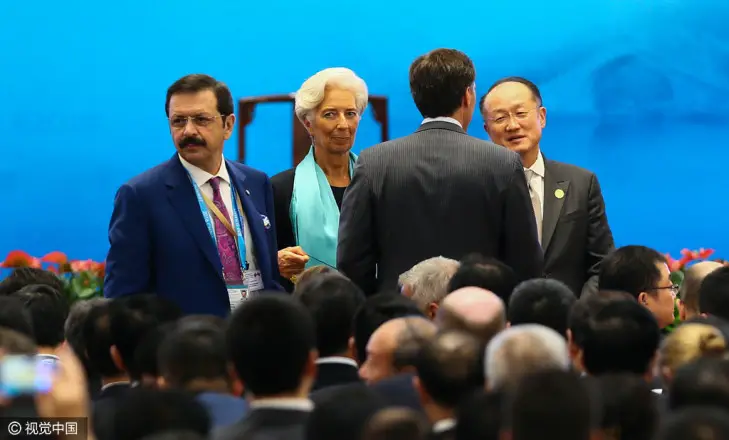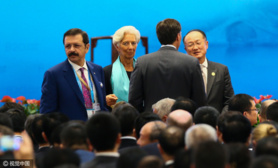Christine Lagarde, managing director of the International Monetary Fund, appeared at the Business 20 (B20) summit opening ceremony in Hangzhou wearing a Hangzhou-crafted blue-green silk scarf. (CFP)
By Huang Tingting Source:Global Times, People’s Daily
China's sericulture grabbed the world's attention on Saturday, when Christine Lagarde, managing director of the International Monetary Fund, appeared at the Business 20 (B20) summit opening ceremony in Hangzhou wearing a Hangzhou-crafted blue-green silk scarf featuring the Three Pools Mirroring the Moon - a famous scenic attraction in the city's West Lake.
Silk is making an appearance everywhere at the G20 and B20 summits. Weeks ago it was revealed that silk scarves and handbags would be given as gifts to the first ladies of world leaders attending the G20 summit, while journalists arriving at the G20 summit a few days ago also received scarves made from what the scarves' manufacturer, Zhejiang-based producer Dali Silk, described as "first-class silk produced from a special local silkworm."
"As one of China's most important silk producing areas, Hangzhou should give its very best to the world at the summit," Zhao Feng, curator of the Chinese National Silk Museum in Hangzhou, told the Global Times on Thursday, when asked why items made from silk had been chosen as gifts for the G20 summit.
Historical legacy
According to Zhao, the tradition of "silk diplomacy" dates back to the Han Dynasty (206BC-AD220), when Zhang Qian, an imperial envoy of Emperor Wu, gifted leaders of countries along the Silk Road with silk as part of efforts to create alliance to fight against the Xiongnu, nomadic people that lived north of China.
According to ancient Chinese legend, Leizu, the wife of the Yellow Emperor, was the first person to raise silkworms thousands of years ago.
This legend was given more credence after half of a cocoon of a domesticated silkworm dating back 5,600-6,000 years was unearthed in North China's Shanxi Province.
One of China's most important exports, in ancient times rulers would go to great lengths to protect the secrets of its production. For example, during the Northern Wei Dynasty (386-534) anyone smuggling silkworms or silkworm cocoons outside of China faced the death penalty.
Today, silk production has already spread to countries across Asia, Europe and the Americas.
However, despite this, "silk, an item commonly used in trade between China and Western countries since ancient times, is still a well-regarded symbol of China in many countries around the world," Zhao noted.
Modern fashion
Silk today not only embodies the history of contact between the East-West, it is also a symbol of modernity and fashion.
"Today, you'll find silk-made accessories and garments displayed in many high-end fashion stores in the US and Europe," Zhao said.
"Which proves that silk is a welcome symbol in East-West cultural exchange."
From colored silk outfits worn by leaders at the 2014 APEC summit to big-brand designs shown off at international fashion shows, silk as a fashion element has won an irreplaceable place in the fashion industry. An increasing number of Chinese designers are turning to silk to demonstrate the beauty of the East to the world.
Wu Haiyan, a designer who created the uniform for Hangzhou G20 volunteers, is one of many such designers.
"Silk is a vital part of my design," she said in an interview with the Hangzhou Daily on Tuesday.
Emerging Chinese designers who have debuted at global fashion shows in recent years, such as Uma Wang and Zhang Huishan, also make use of printed silk to show off their "Chinese style."
As for why silk has been so well-received, Zhao explained, "As a natural material that is easy to dye, silk can come in many different colors. This helps spark artists' creativity."
Despite these success stories, it seems China's silk fashion industry still needs a push to go even further.
According to the official website of the China International Silk Expo, which is scheduled to open in mid-October in Hangzhou, Chinese silk fashion brands are not as competitive as their European and US counterparts. As such, this year's expo will focus on 3D-printed silk materials used in clothing and home textile designs in order to help designers learn how to "apply modern technology to traditional silk design."
By Huang Tingting Source:Global Times, People’s Daily
China's sericulture grabbed the world's attention on Saturday, when Christine Lagarde, managing director of the International Monetary Fund, appeared at the Business 20 (B20) summit opening ceremony in Hangzhou wearing a Hangzhou-crafted blue-green silk scarf featuring the Three Pools Mirroring the Moon - a famous scenic attraction in the city's West Lake.
Silk is making an appearance everywhere at the G20 and B20 summits. Weeks ago it was revealed that silk scarves and handbags would be given as gifts to the first ladies of world leaders attending the G20 summit, while journalists arriving at the G20 summit a few days ago also received scarves made from what the scarves' manufacturer, Zhejiang-based producer Dali Silk, described as "first-class silk produced from a special local silkworm."
"As one of China's most important silk producing areas, Hangzhou should give its very best to the world at the summit," Zhao Feng, curator of the Chinese National Silk Museum in Hangzhou, told the Global Times on Thursday, when asked why items made from silk had been chosen as gifts for the G20 summit.
Historical legacy
According to Zhao, the tradition of "silk diplomacy" dates back to the Han Dynasty (206BC-AD220), when Zhang Qian, an imperial envoy of Emperor Wu, gifted leaders of countries along the Silk Road with silk as part of efforts to create alliance to fight against the Xiongnu, nomadic people that lived north of China.
According to ancient Chinese legend, Leizu, the wife of the Yellow Emperor, was the first person to raise silkworms thousands of years ago.
This legend was given more credence after half of a cocoon of a domesticated silkworm dating back 5,600-6,000 years was unearthed in North China's Shanxi Province.
One of China's most important exports, in ancient times rulers would go to great lengths to protect the secrets of its production. For example, during the Northern Wei Dynasty (386-534) anyone smuggling silkworms or silkworm cocoons outside of China faced the death penalty.
Today, silk production has already spread to countries across Asia, Europe and the Americas.
However, despite this, "silk, an item commonly used in trade between China and Western countries since ancient times, is still a well-regarded symbol of China in many countries around the world," Zhao noted.
Modern fashion
Silk today not only embodies the history of contact between the East-West, it is also a symbol of modernity and fashion.
"Today, you'll find silk-made accessories and garments displayed in many high-end fashion stores in the US and Europe," Zhao said.
"Which proves that silk is a welcome symbol in East-West cultural exchange."
From colored silk outfits worn by leaders at the 2014 APEC summit to big-brand designs shown off at international fashion shows, silk as a fashion element has won an irreplaceable place in the fashion industry. An increasing number of Chinese designers are turning to silk to demonstrate the beauty of the East to the world.
Wu Haiyan, a designer who created the uniform for Hangzhou G20 volunteers, is one of many such designers.
"Silk is a vital part of my design," she said in an interview with the Hangzhou Daily on Tuesday.
Emerging Chinese designers who have debuted at global fashion shows in recent years, such as Uma Wang and Zhang Huishan, also make use of printed silk to show off their "Chinese style."
As for why silk has been so well-received, Zhao explained, "As a natural material that is easy to dye, silk can come in many different colors. This helps spark artists' creativity."
Despite these success stories, it seems China's silk fashion industry still needs a push to go even further.
According to the official website of the China International Silk Expo, which is scheduled to open in mid-October in Hangzhou, Chinese silk fashion brands are not as competitive as their European and US counterparts. As such, this year's expo will focus on 3D-printed silk materials used in clothing and home textile designs in order to help designers learn how to "apply modern technology to traditional silk design."
 Menu
Menu
 Chinese silk a highlight of the G20 and B20 summits in Hangzhou
Chinese silk a highlight of the G20 and B20 summits in Hangzhou

















